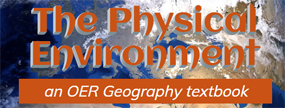 CONTENTS | ATLAS | GOOGLE EARTH
CONTENTS | ATLAS | GOOGLE EARTHChapter Review Assess your understanding of concepts related to this chapter by answering the questions below. Click the question to reveal the correct answer.
Shortwave radiation penetrates through the atmosphere and is absorbed by the surface. The surface radiates longwave radiation toward the atmosphere. The atmosphere absorbs this energy and radiates it back down toward the surface. Increasing "greenhouse gasses" though human activities traps more radiation causing an increase in near-surface temperatures.
Troposphere: temperature decreases with an increase in elevation. Tropopause: no change in temperature with an increase in elevation. Stratosphere: temperature increases with an increase in elevation. Stratopause: no change in temperature with an increase in elevation.
Particulates can reflect incoming shortwave and cause atmospheric cooling. They are also good absorbers of terrestrial earth radiation which would cause atmospheric warming. Particulates serve as condensation nuclei.
An inversion occurs when air temperatures increase with an increase in elevation. Inversions can occur under the right conditions in the troposphere. The stratosphere is noted for its inversion.
The environmental lapse rate of temperature is the decrease in temperature with an increase in elevation through the troposphere. The temperature decreases with elevation because the earth is the immediate source of energy to heat the air.
Fossil fuel burning (e.g., emissions from transportation and energy generation), deforestation, cattle farming
and rice production to name a few.
Ozone is an eye irritant and causes shortness of
breath due to constricting air ways in the throat and lungs.
Because ozone absorbs incoming solar radiation. The
top of the stratosphere is hotter because its closer to the source of
shortwave radiation. An ever diminishing amount of shortwave radiation as it
passes through the stratosphere causes the temperature to decrease toward
the bottom.
Clouds can reflect solar radiation off the top of
the cloud causing atmospheric cooling. They are good absorbers of
terrestrial earth radiation which would cause atmospheric warming. The role
of clouds in climate change is one of the most vexing problems to climate
scientists.
Methane is a product of the decomposition of organic matter, with major
natural sources being that which occurs in wetlands, melting permafrost and as a by-product termite actvities. Methane is a greenhouse gas.
|